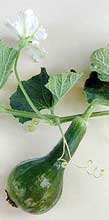View crop
View crop Data sheet EcoPortLagenaria siceraria
 |
|
| Notes |
|---|
| BRIEF DESCRIPTION A long ribbed vine with strong tendrils and hard-shelled fruits. The fruit is a pepo, very variable in size and shape, often globular, bottle- or club-shaped, up to 1 m or more long. USES Mature fruit rinds are made into utensils and containers. Immature fruit flesh of selected cultivars is used as a vegetable, usually boiled, fried, dried or in stews. Cultivars differ markedly in sweetness or bitterness. Young shoots can be eaten as a green. The seeds are a popular snack and the can be extracted for oil. The fruit has medicinal properties. GROWING PERIOD Annual vine, growing 70-90 days for immature fruit and 100-120 days for mature fruit. Some cultivars have a relatively short growing period of 60-80 days. COMMON NAMES Bottle gourd, White-flowerd gourd, Calabash gourd, Calebasse, Trumpet gourd, Calebassier, Courge bouteille, Cojombro, guiro amargo, Upo, Talayag, Cucuzzi, Zuggo melon, Mo kwa, Oo lo kwa, Labu air, Labu butih, Kukuk, Labu botol, Sel kambang, Botol wara, Upo, Tabungaw, Kalubay, Khlook, Namz taux, Namtao, Manamtao, Khi-luu-saa. FURTHER INF Scientific synonym: L. vulgaris, L. leucantha, Cucurbita lagenaria. Bottle gourd probably originated in tropical Africa and now has pantropical distribution. It can be grown year-round at elevations up to 1600 m but economical yields are usually only obtained below 500 m. Short days promote flower formation but have no effect on sex expression. It may be cultivated in either a dry or wet season. Each plant yields about 10-15 fruits. Good yields may be about 20-30 t/ha or 2-3 kg/m˝ and optimal yields may be up to 40-60 t/ha. | Sources |
| SOURCES (L. siceraria (Molina) Standley) Tindall H 1983 pp 171-173 [RAIN, LIG, FER, PH, DRA] Rice R 1990 pp 248-249 [RAIN, FER] Duke J 1975 pp 19 [PH, RAIN, TEMP] Roecklein J 1987 pp 479 [USE] Siemonsma J 1993 pp 190-192 [USE, TEMP, KTMP, PHO, TEXT, DRA, PH] |